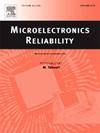Reliability prediction of electronic components based on physical of failure with manufacturing parameters fluctuations
IF 1.6
4区 工程技术
Q3 ENGINEERING, ELECTRICAL & ELECTRONIC
引用次数: 0
Abstract
Reliability prediction based on the physics of failure (PoF) methodology involves examining the physical variables that impact the performance parameters of electronic components, developing mathematical models to describe the evolution of these parameters, and predicting the components' reliable operational lifespan. However, the current PoF model does not account for the influence of manufacturing parameters, such as material properties and structural characteristics, which limits the accuracy of reliability predictions. Therefore, establishing a PoF model that incorporates manufacturing parameters is a critical challenge in enhancing reliability prediction accuracy. To overcome this limitation, an improved PoF model incorporating manufacturing parameters is proposed in this study. The study examines how the manufacturing parameters influence the PoF model, then develops an adapted PoF model that incorporates these factors for improved predictive accuracy. Then, a parameter estimation method based on Long Short-Term Memory (LSTM) is proposed, with the Hybrid Bat Algorithm (HBA) employed to adaptively optimize the network's parameters. Finally, the effectiveness of the proposed method is demonstrated through a case study on an electromagnetic relay. Compared to the actual lifespan, the reliability prediction model incorporating manufacturing parameters accurately estimates the relay's lifetime, achieving deviation of only 5.8 % at 100,000 cycles, thereby verifying the model is feasibility and effectiveness.
基于制造参数波动的物理失效的电子元件可靠性预测
基于故障物理(PoF)方法的可靠性预测包括检查影响电子元件性能参数的物理变量,开发数学模型来描述这些参数的演变,并预测组件的可靠使用寿命。然而,目前的PoF模型并没有考虑到制造参数的影响,如材料性能和结构特性,这限制了可靠性预测的准确性。因此,建立一个包含制造参数的PoF模型是提高可靠性预测精度的关键挑战。为了克服这一限制,本研究提出了一种包含制造参数的改进PoF模型。该研究考察了制造参数如何影响PoF模型,然后开发了一个适应的PoF模型,该模型包含了这些因素,以提高预测精度。然后,提出了一种基于长短期记忆(LSTM)的参数估计方法,采用混合蝙蝠算法(Hybrid Bat Algorithm, HBA)对网络参数进行自适应优化。最后,通过一个电磁继电器的算例验证了所提方法的有效性。与实际寿命相比,结合制造参数的可靠性预测模型准确地估计了继电器的寿命,在100,000次循环下偏差仅为5.8%,从而验证了模型的可行性和有效性。
本文章由计算机程序翻译,如有差异,请以英文原文为准。
求助全文
约1分钟内获得全文
求助全文
来源期刊

Microelectronics Reliability
工程技术-工程:电子与电气
CiteScore
3.30
自引率
12.50%
发文量
342
审稿时长
68 days
期刊介绍:
Microelectronics Reliability, is dedicated to disseminating the latest research results and related information on the reliability of microelectronic devices, circuits and systems, from materials, process and manufacturing, to design, testing and operation. The coverage of the journal includes the following topics: measurement, understanding and analysis; evaluation and prediction; modelling and simulation; methodologies and mitigation. Papers which combine reliability with other important areas of microelectronics engineering, such as design, fabrication, integration, testing, and field operation will also be welcome, and practical papers reporting case studies in the field and specific application domains are particularly encouraged.
Most accepted papers will be published as Research Papers, describing significant advances and completed work. Papers reviewing important developing topics of general interest may be accepted for publication as Review Papers. Urgent communications of a more preliminary nature and short reports on completed practical work of current interest may be considered for publication as Research Notes. All contributions are subject to peer review by leading experts in the field.
 求助内容:
求助内容: 应助结果提醒方式:
应助结果提醒方式:


